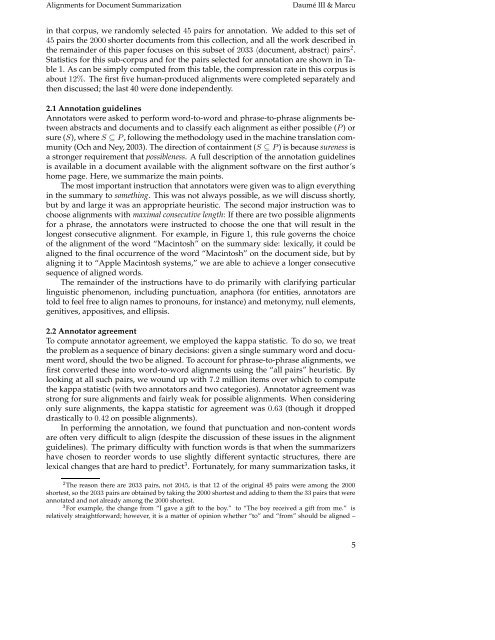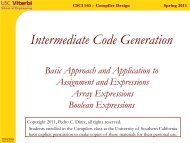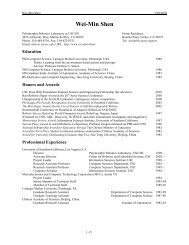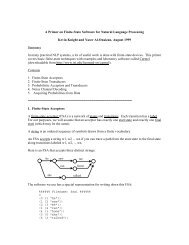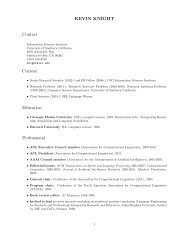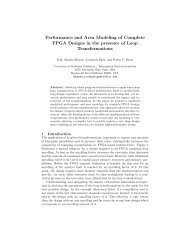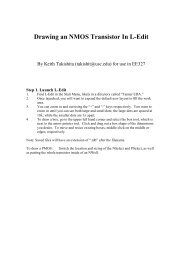Induction of Word and Phrase Alignments for Automatic Document ...
Induction of Word and Phrase Alignments for Automatic Document ...
Induction of Word and Phrase Alignments for Automatic Document ...
Create successful ePaper yourself
Turn your PDF publications into a flip-book with our unique Google optimized e-Paper software.
<strong>Alignments</strong> <strong>for</strong> <strong>Document</strong> Summarization Daumé III & Marcu<br />
in that corpus, we r<strong>and</strong>omly selected 45 pairs <strong>for</strong> annotation. We added to this set <strong>of</strong><br />
45 pairs the 2000 shorter documents from this collection, <strong>and</strong> all the work described in<br />
the remainder <strong>of</strong> this paper focuses on this subset <strong>of</strong> 2033 〈document, abstract〉 pairs 2 .<br />
Statistics <strong>for</strong> this sub-corpus <strong>and</strong> <strong>for</strong> the pairs selected <strong>for</strong> annotation are shown in Table<br />
1. As can be simply computed from this table, the compression rate in this corpus is<br />
about 12%. The first five human-produced alignments were completed separately <strong>and</strong><br />
then discussed; the last 40 were done independently.<br />
2.1 Annotation guidelines<br />
Annotators were asked to per<strong>for</strong>m word-to-word <strong>and</strong> phrase-to-phrase alignments between<br />
abstracts <strong>and</strong> documents <strong>and</strong> to classify each alignment as either possible (P ) or<br />
sure (S), where S ⊆ P , following the methodology used in the machine translation community<br />
(Och <strong>and</strong> Ney, 2003). The direction <strong>of</strong> containment (S ⊆ P ) is because sureness is<br />
a stronger requirement that possibleness. A full description <strong>of</strong> the annotation guidelines<br />
is available in a document available with the alignment s<strong>of</strong>tware on the first author’s<br />
home page. Here, we summarize the main points.<br />
The most important instruction that annotators were given was to align everything<br />
in the summary to something. This was not always possible, as we will discuss shortly,<br />
but by <strong>and</strong> large it was an appropriate heuristic. The second major instruction was to<br />
choose alignments with maximal consecutive length: If there are two possible alignments<br />
<strong>for</strong> a phrase, the annotators were instructed to choose the one that will result in the<br />
longest consecutive alignment. For example, in Figure 1, this rule governs the choice<br />
<strong>of</strong> the alignment <strong>of</strong> the word “Macintosh” on the summary side: lexically, it could be<br />
aligned to the final occurrence <strong>of</strong> the word “Macintosh” on the document side, but by<br />
aligning it to “Apple Macintosh systems,” we are able to achieve a longer consecutive<br />
sequence <strong>of</strong> aligned words.<br />
The remainder <strong>of</strong> the instructions have to do primarily with clarifying particular<br />
linguistic phenomenon, including punctuation, anaphora (<strong>for</strong> entities, annotators are<br />
told to feel free to align names to pronouns, <strong>for</strong> instance) <strong>and</strong> metonymy, null elements,<br />
genitives, appositives, <strong>and</strong> ellipsis.<br />
2.2 Annotator agreement<br />
To compute annotator agreement, we employed the kappa statistic. To do so, we treat<br />
the problem as a sequence <strong>of</strong> binary decisions: given a single summary word <strong>and</strong> document<br />
word, should the two be aligned. To account <strong>for</strong> phrase-to-phrase alignments, we<br />
first converted these into word-to-word alignments using the “all pairs” heuristic. By<br />
looking at all such pairs, we wound up with 7.2 million items over which to compute<br />
the kappa statistic (with two annotators <strong>and</strong> two categories). Annotator agreement was<br />
strong <strong>for</strong> sure alignments <strong>and</strong> fairly weak <strong>for</strong> possible alignments. When considering<br />
only sure alignments, the kappa statistic <strong>for</strong> agreement was 0.63 (though it dropped<br />
drastically to 0.42 on possible alignments).<br />
In per<strong>for</strong>ming the annotation, we found that punctuation <strong>and</strong> non-content words<br />
are <strong>of</strong>ten very difficult to align (despite the discussion <strong>of</strong> these issues in the alignment<br />
guidelines). The primary difficulty with function words is that when the summarizers<br />
have chosen to reorder words to use slightly different syntactic structures, there are<br />
lexical changes that are hard to predict 3 . Fortunately, <strong>for</strong> many summarization tasks, it<br />
2 The reason there are 2033 pairs, not 2045, is that 12 <strong>of</strong> the original 45 pairs were among the 2000<br />
shortest, so the 2033 pairs are obtained by taking the 2000 shortest <strong>and</strong> adding to them the 33 pairs that were<br />
annotated <strong>and</strong> not already among the 2000 shortest.<br />
3 For example, the change from “I gave a gift to the boy.” to “The boy received a gift from me.” is<br />
relatively straight<strong>for</strong>ward; however, it is a matter <strong>of</strong> opinion whether “to” <strong>and</strong> “from” should be aligned –<br />
5


